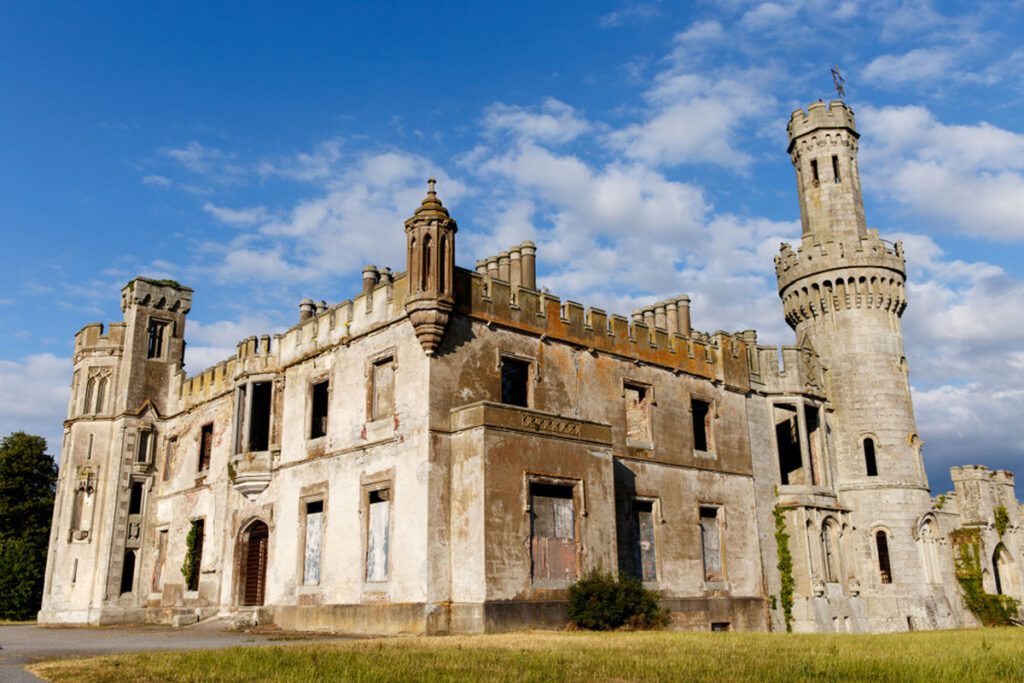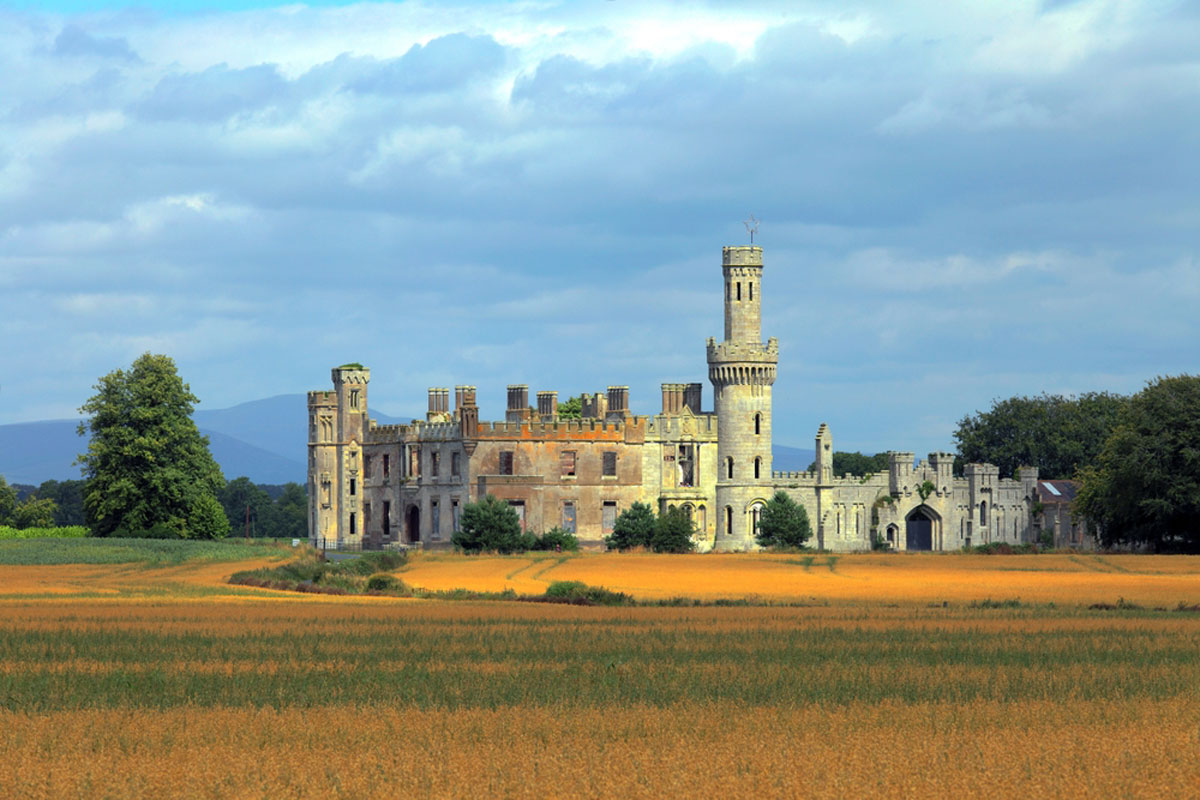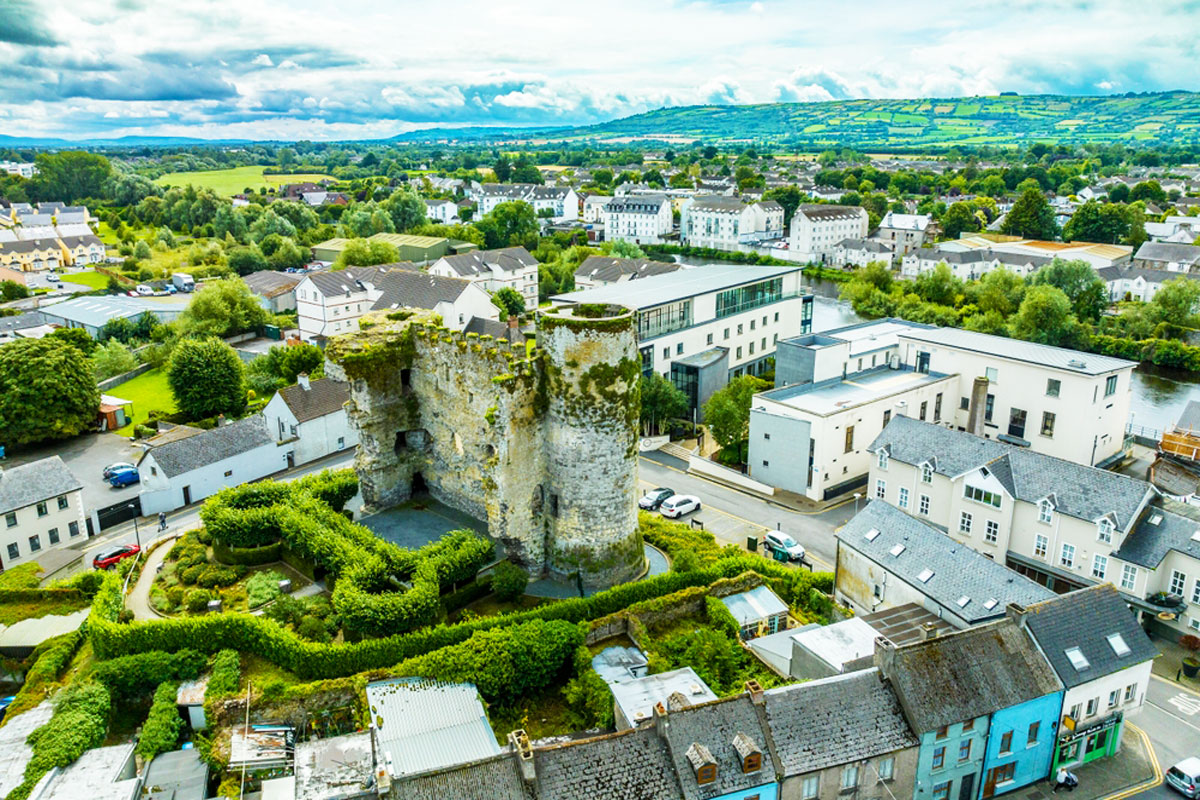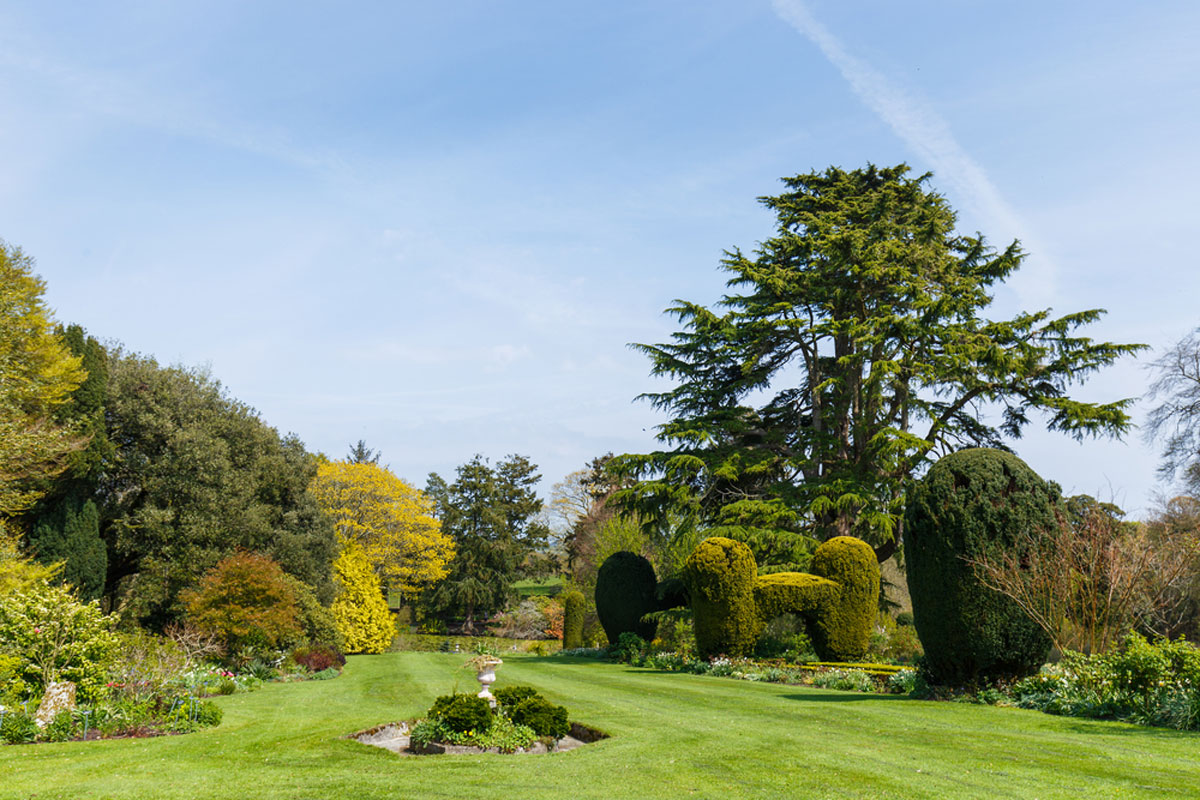A Legacy in Stone
Rising from the rolling green fields of County Carlow, the skeletal remains of Duckett’s Grove stand as a hauntingly beautiful relic of Ireland’s past. This once-grand Gothic mansion, with its towering battlements and elaborate stonework, was the seat of the influential Duckett family for over two centuries. Today, it exists in a state of picturesque ruin, its ivy-clad walls whispering stories of faded opulence, tragic loss, and ghostly echoes.
Constructed in the 18th century, Duckett’s Grove evolved into a striking example of Gothic Revival architecture, adorned with turrets, gargoyles, and sweeping archways. The mansion was more than just a home; it was a symbol of prestige, hosting lavish gatherings attended by aristocrats, artists, and politicians of the time. Yet, despite its grandeur, the fortunes of the Duckett family would not last forever.
Through the years, the estate was expanded and reimagined, reflecting the ambitions of successive generations. However, as Ireland entered a period of social and political upheaval, the once-thriving household began its slow decline. By the early 20th century, Duckett’s Grove had changed hands multiple times, its fate mirroring that of many grand country estates left to ruin.
Now an iconic ruin, the mansion and its surrounding gardens have become a place of mystery and intrigue, drawing visitors who seek both history and the supernatural. But before we delve into the tales of ghosts and hidden treasures, we must first understand the people who built and lived within these once-glorious walls.
The Rise of the Ducketts – A Dynasty in the Making
The story of Duckett’s Grove is inseparable from the family that gave it its name. The Ducketts were a wealthy Anglo-Irish family who rose to prominence in the 18th century, amassing land, influence, and power in County Carlow. Their legacy, though now a ghostly shadow, was once one of affluence and ambition, shaping the very landscape of the region.
The family’s ascent began with the arrival of the first Ducketts in Ireland during the early 1700s. Originally of English descent, they quickly established themselves as landlords and entrepreneurs, acquiring vast tracts of land. By the late 18th century, they had become one of the most prosperous families in the county, known for their agricultural advancements and business acumen.
It was in this era of prosperity that the foundations of Duckett’s Grove were laid. Built as a grand country house, the estate was continually expanded and modified by successive generations, transforming it from a stately home into an architectural marvel of the Gothic Revival style. Towering turrets, intricate stone carvings, and dramatic archways gave the mansion a fairy-tale appearance, befitting the wealth and status of its owners.
The Ducketts were more than mere landlords; they were figures of local importance, involved in politics, land management, and high society. The estate became a hub of aristocratic life, hosting extravagant balls, fox hunts, and garden parties that attracted some of Ireland’s most influential figures. Their lands stretched for miles, cultivated by tenants who worked under the family’s patronage.
However, the grandeur of Duckett’s Grove was not built on wealth alone. Like many Anglo-Irish families of the time, the Ducketts maintained their position through a complex and often contentious relationship with the local Irish population. While they were seen as benevolent landlords by some, others viewed them as symbols of colonial rule, a reality that would play a significant role in the family’s eventual downfall.
As the 19th century progressed, the Ducketts reached the height of their power, but shadows loomed on the horizon. Social and economic changes, combined with the shifting political landscape of Ireland, would soon test the resilience of the family and their magnificent estate.
The Decline and Fall – Ruin in the Wake of Change
At the height of its glory, Duckett’s Grove stood as a proud symbol of aristocratic wealth, its turrets piercing the sky, its gardens blooming with exotic plants, and its halls echoing with the laughter of Ireland’s elite. But like many grand estates of the Anglo-Irish gentry, its fortunes were bound to the shifting tides of history. What was built in an era of colonial dominance would not survive the waves of political, social, and economic upheaval that swept across Ireland in the 19th and early 20th centuries.
The first cracks in the Duckett dynasty appeared with the changing economic landscape. The once-lucrative agricultural lands that had sustained the estate were hit hard by the Great Famine (1845–1852), a catastrophe that devastated Ireland’s rural population. While the Ducketts, like many wealthy landlords, weathered the famine better than their tenants, the strain on estate finances was undeniable. Rent collection became increasingly difficult as tenant farmers struggled to survive, and tensions between the landowning class and the Irish peasantry grew sharper.
Adding to their troubles was the rise of Irish nationalism. Movements like the Land War of the late 19th century sought to dismantle the Anglo-Irish aristocracy’s grip on Irish land. The Ducketts, once powerful and unchallenged, found themselves at odds with a growing tide of resentment and rebellion. Their vast estate began to shrink as parcels of land were sold or lost to land reforms, eroding the wealth that had once sustained their extravagant lifestyle.
By the early 20th century, the last of the Duckett family had departed from the mansion, leaving it abandoned. The once-magnificent home, filled with art, fine furniture, and relics of a golden age, fell into disrepair. In 1933, a fire swept through the empty halls, sealing its fate as a ruin. The cause of the fire remains a mystery—some speculate it was accidental, while others believe it was an act of arson linked to the turbulent political climate of the time.
What was once a symbol of power had become a crumbling relic, its turrets now standing as silent sentinels over an estate reclaimed by nature. The opulent balls, the grand feasts, the aristocratic gatherings—all had faded into history, leaving only echoes in the wind.
But though the Ducketts were gone, their legacy was far from forgotten. If anything, Duckett’s Grove took on a new life in the realm of folklore, mystery, and the supernatural. Stories of ghostly apparitions, eerie whispers, and spectral figures roaming the ruins would soon turn the estate into one of Ireland’s most haunted locations.

Ghosts of Duckett’s Grove – A Mansion of Mystery and Hauntings
As the years passed and Duckett’s Grove fell into ruin, a new chapter in its story began—one steeped in eerie whispers, ghostly apparitions, and chilling tales of the supernatural. What was once a grand estate of wealth and power had become one of Ireland’s most infamous haunted locations, drawing paranormal investigators and thrill-seekers from all over the world.
Among the many legends surrounding the mansion, none is more famous than that of The Banshee of Duckett’s Grove. It is said that a vengeful spirit haunts the ruins, her wailing cries echoing through the abandoned halls and windswept courtyards. According to local folklore, this spectral figure is tied to a tragic love affair that ended in betrayal and heartbreak. Some claim she was a servant who fell in love with a member of the Duckett family, only to meet a tragic fate, while others believe she was a woman scorned, forever cursed to roam the ruins, mourning her lost love.
Witnesses have reported chilling encounters—unexplained whispers, shadowy figures lurking in the doorways, and the distinct feeling of being watched. Some have even claimed to see the figure of a woman in white, drifting through the corridors before vanishing into thin air.
But the banshee is not the only spirit said to dwell within the ruins. Many visitors have described strange occurrences in the overgrown gardens and courtyards—objects moving on their own, sudden temperature drops, and a deep sense of unease. Some say they have heard the sounds of horses galloping across the grounds, remnants of a time when the estate was alive with the energy of aristocratic hunts and lavish gatherings.
Paranormal investigators have attempted to uncover the truth behind the hauntings, using modern ghost-hunting equipment to capture strange anomalies—mysterious voices caught on recordings, unexplained fluctuations in electromagnetic fields, and unidentifiable figures appearing in photographs. Whether one believes in the supernatural or not, there is no denying that Duckett’s Grove carries an air of mystery that refuses to fade with time.
Perhaps the spirits of Duckett’s Grove are the echoes of the past, lingering memories of a family and estate that met an untimely end. Or maybe, as some suggest, the land itself holds a deep, unshakable energy, keeping the shadows of history alive within its ruins.
Whatever the truth may be, Duckett’s Grove remains one of Ireland’s most captivating and haunted landmarks. But even beyond its ghostly legends, the estate holds one more secret—one that continues to fascinate historians and treasure hunters alike.
Lost Riches and Hidden Secrets – The Final Mystery of Duckett’s Grove
Beyond its grandeur, its haunting beauty, and the whispers of ghosts, Duckett’s Grove is said to hold another secret—one that has tantalized historians, treasure hunters, and curious explorers for generations. Somewhere within the ruins, beneath the ivy-clad stones and crumbling archways, rumors persist of a hidden fortune, a treasure lost to time.
Stories of buried riches date back to the mansion’s decline in the early 20th century. As the Duckett family’s fortune dwindled and they abandoned the estate, whispers emerged that they had left behind more than just the empty shell of their once-great home. Some believe that, fearing looters or forced repossession, the Ducketts may have hidden gold, jewelry, or even priceless family heirlooms within the walls, beneath the floors, or somewhere deep within the estate’s sprawling grounds.
Treasure hunters have long sought clues in the mansion’s ruins, sifting through the remnants of its past, hoping to uncover a lost vault or secret chamber. Some speculate that the answers may lie within the mansion’s underground tunnels, which were rumored to have connected various parts of the estate, serving as escape routes or hidden storage spaces. However, no confirmed discovery has ever been made, leaving the legend of the lost riches an unsolved enigma.
Adding to the mystery, locals tell tales of a cursed fortune—one that, if ever found, would bring misfortune to those who disturb it. This belief is rooted in the many tragedies associated with Duckett’s Grove, from the family’s decline to the destructive fire that sealed its fate. Some say that the ghosts who linger in the ruins are not just restless souls, but guardians of whatever secrets remain buried beneath the estate.
Despite its ruined state, Duckett’s Grove continues to captivate visitors with its haunting beauty, rich history, and lingering mysteries. Whether one visits to admire the Gothic architecture, explore the restored walled gardens, or seek out paranormal encounters, the estate remains one of Ireland’s most enigmatic landmarks.
Perhaps one day, the lost riches of Duckett’s Grove will be uncovered, revealing long-forgotten secrets of the Duckett family’s past. Or maybe, just like the ghosts that are said to roam its halls, the treasure is destined to remain nothing more than a legend—one last mystery, hidden within the shadows of history.
The ruins stand, the whispers linger, and the legend lives on.
Historical and Cultural Sites
- Carlow Castle – A 13th-century castle ruin located near the River Barrow.
- Browne’s Hill Dolmen – A massive prehistoric portal tomb with the largest capstone in Europe.
- Duckett’s Grove – A ruined Gothic mansion surrounded by beautiful gardens and woodland.
- County Carlow Military Museum – A fascinating collection of artifacts showcasing Carlow’s military history.
- St. Mullins Monastic Site – An ancient ecclesiastical site with scenic river views.
Natural Attractions
- Mount Leinster – A stunning mountain offering hiking trails and panoramic views.
- Blackstairs Mountains – Ideal for walking, hiking, and enjoying unspoiled natural beauty.
- Altamont Gardens – Renowned for their romantic and tranquil landscape with a mix of formal and wild gardens.
- Rathwood – A family-friendly destination with a forest walk, activities, and a train ride.
- River Barrow Way – A scenic route for walking, cycling, or boating along one of Ireland’s most beautiful rivers.
Cultural and Arts Experiences
- Visual Carlow – A contemporary arts center featuring exhibitions and performances.
- Carlow County Museum – Showcasing the rich history and heritage of the county.
Religious and Spiritual Sites
- Leighlinbridge Cathedral (St. Laserian’s Cathedral) – A historic cathedral dating back to the 13th century.
- St. Mullins Heritage Centre – Learn about the history of this historic village and its religious roots.
Unique Experiences
- Carlow Brewing Company (O’Hara’s Brewery) – A local brewery offering tours and tastings of craft beers.
- Brownshill Dolmen – An iconic archaeological site featuring a mysterious prehistoric structure.
- Borris House – A historic estate and home of the MacMurrough Kavanagh family, with beautiful grounds and guided tours.
County Carlow may be one of Ireland’s smaller counties, but its mix of history, natural beauty, and cultural attractions make it a must-visit destination.
Helpful Resources






